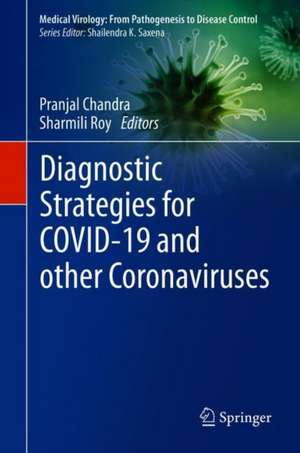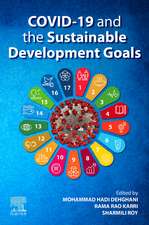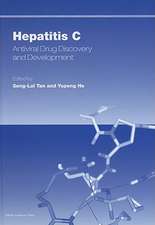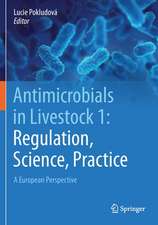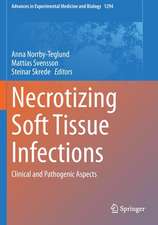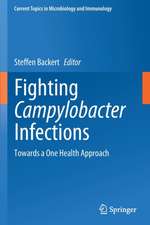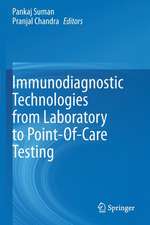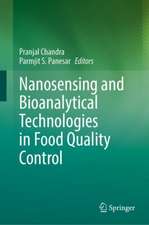Diagnostic Strategies for COVID-19 and other Coronaviruses: Medical Virology: From Pathogenesis to Disease Control
Editat de Pranjal Chandra, Sharmili Royen Limba Engleză Hardback – 5 dec 2020
In turn, the book evaluates the potential of CRISPR-Cas 12-based assays for the detection of SARS-CoV-2 using RNA extracted from patients. Lastly, it discusses the use of miniaturized biosensors for the detection of other types of coronavirus.
| Toate formatele și edițiile | Preț | Express |
|---|---|---|
| Paperback (1) | 877.85 lei 38-44 zile | |
| Springer Nature Singapore – 5 dec 2021 | 877.85 lei 38-44 zile | |
| Hardback (1) | 1109.16 lei 3-5 săpt. | |
| Springer Nature Singapore – 5 dec 2020 | 1109.16 lei 3-5 săpt. |
Preț: 1109.16 lei
Preț vechi: 1352.63 lei
-18% Nou
Puncte Express: 1664
Preț estimativ în valută:
212.24€ • 222.61$ • 176.68£
212.24€ • 222.61$ • 176.68£
Carte disponibilă
Livrare economică 11-25 martie
Preluare comenzi: 021 569.72.76
Specificații
ISBN-13: 9789811560057
ISBN-10: 9811560056
Pagini: 199
Ilustrații: VIII, 199 p. 65 illus., 49 illus. in color.
Dimensiuni: 155 x 235 mm
Greutate: 0.45 kg
Ediția:1st ed. 2020
Editura: Springer Nature Singapore
Colecția Springer
Seria Medical Virology: From Pathogenesis to Disease Control
Locul publicării:Singapore, Singapore
ISBN-10: 9811560056
Pagini: 199
Ilustrații: VIII, 199 p. 65 illus., 49 illus. in color.
Dimensiuni: 155 x 235 mm
Greutate: 0.45 kg
Ediția:1st ed. 2020
Editura: Springer Nature Singapore
Colecția Springer
Seria Medical Virology: From Pathogenesis to Disease Control
Locul publicării:Singapore, Singapore
Cuprins
Chapter 1. Insights into novel coronavirus detection and COVID-19 outbreak.- Chapter 2. Immunosensing technology for rapid detection of COVID-19 in remote settings.- Chapter 3. Molecular techniques for high-speed detection of COVID-19: Present and future perspective.- Chapter 4. Current efforts in theranostic approaches for COVID-19 management.- Chapter 5. Post treatment detection and monitoring of COVID-19.- Chapter 6. Genetic analysis, structural determination, and immune responses of COVID-19 proteins: A total diagnostic perspective.- Chapter 7. CRISPER-CAS based precise detection for COVID-19.- Chapter 8. Miniaturized biosensors for detection of other coronona virus.
Notă biografică
Prof. Pranjal Chandra is currently serving as an Assistant Professor at the School of Biochemical Engineering, Indian Institute of Technology (BHU), Varanasi, India. He received his Ph.D. from Pusan National University, South Korea and completed his post-doctoral training at Technion - Israel Institute of Technology, Israel. His research focus is highly interdisciplinary, combining biotechnology, nanobiosensors, material engineering, nanomedicine etc. He has designed several commercially viable biosensing prototypes that can be used for onsite analysis in the context of biomedical diagnostics. He has published four books on various aspects of biosensors / medical diagnostics with IET London, Springer Nature, and CRC Press USA, as well as over 100 journal articles in the leading journals / books in his research area. He is the recipient of many prestigious awards and fellowships, e.g. the DST Ramanujan Fellowship (Government of India); ECRA (DST, Government of India); BK-21 and NRF Fellowship, South Korea; Technion Post-doctoral Fellowship, Israel; NMS Young Scientist Award; BRSI Young Scientist Award; RSC Highly Cited Corresponding Author Award (general chemistry); and ACS / Elsevier Outstanding Reviewer Awards. He is a reviewer for over 50 international journals and expert project reviewer for various national / international funding agencies. Further, he is an Associate Editor of the journal Sensors International and an editorial board member of Materials Science for Energy Technologies; World Journal of Methodology, USA; Frontiers of Biosciences, USA; and Reports in Physical Sciences, Singapore
Dr. Sharmili Roy is currently pursuing her second Post-Doctoral Research in Oncology / Medical Research at the Division of Oncology, School of Medicine, Stanford University, California, USA. She earned her Ph.D. from Universiti of Brunei Darussalam, Brunei under the supervision of Prof. Minhaz Uddin Ahmed. Prior to joining Stanford University, she worked for her first Post-Doctoral training at the Indian Institute of Technology Guwahati, India under supervision of Prof. Pranjal Chandra. Her current research is focused on the development of Next Generation Sequencing technology (NGS) with various clinical samples especially with many kinds of cancer DNA samples, molecular diagnostics on cancer, and DNA digital data storage process. She has expertized on point of care biosensors technology development based on Loop-mediated isothermal amplification (LAMP) during her Ph.D. tenure. She has published several high impact factor research papers, 3 USA patents, 4 book chapters in Biosensors and Bioelectronics, Analytical Methods, ACS sensors, Food Control, Food chemistry, Electroanalysis, etc. She is a recipient of many prestigious fellowships such as; Free education scholarships for Master studies by Government of Sweden, Graduate Research Scholarships (GRS) from Ministry of education, the government of Brunei, SERB-National Post Doctorate Fellowship (NPDF) from Department of Science and Technology (DST), Government of India, and Post-doctoral fellowship from Stanford University, USA.
Dr. Sharmili Roy is currently pursuing her second Post-Doctoral Research in Oncology / Medical Research at the Division of Oncology, School of Medicine, Stanford University, California, USA. She earned her Ph.D. from Universiti of Brunei Darussalam, Brunei under the supervision of Prof. Minhaz Uddin Ahmed. Prior to joining Stanford University, she worked for her first Post-Doctoral training at the Indian Institute of Technology Guwahati, India under supervision of Prof. Pranjal Chandra. Her current research is focused on the development of Next Generation Sequencing technology (NGS) with various clinical samples especially with many kinds of cancer DNA samples, molecular diagnostics on cancer, and DNA digital data storage process. She has expertized on point of care biosensors technology development based on Loop-mediated isothermal amplification (LAMP) during her Ph.D. tenure. She has published several high impact factor research papers, 3 USA patents, 4 book chapters in Biosensors and Bioelectronics, Analytical Methods, ACS sensors, Food Control, Food chemistry, Electroanalysis, etc. She is a recipient of many prestigious fellowships such as; Free education scholarships for Master studies by Government of Sweden, Graduate Research Scholarships (GRS) from Ministry of education, the government of Brunei, SERB-National Post Doctorate Fellowship (NPDF) from Department of Science and Technology (DST), Government of India, and Post-doctoral fellowship from Stanford University, USA.
Textul de pe ultima copertă
This book provides fundamental information on various techniques for the detection of SARS-CoV-2 including reverse transcriptase (RT) PCR, loop-mediated isothermal amplification, immunodiagnostic tests, and CRISPR-Cas. It reviews various testing kits and detection methodologies that are currently being used for the detection of SARS-CoV-2 and examines strategies for the post-treatment detection and monitoring of SARS-CoV-2. Further, it assesses the diagnostic potential of several SARS-CoV-2 proteins; and analyzes their structural determinants and immunogenicity.
In turn, the book evaluates the potential of CRISPR-Cas 12-based assays for the detection of SARS-CoV-2 using RNA extracted from patients. Lastly, it discusses the use of miniaturized biosensors for the detection of other types of coronavirus.
In turn, the book evaluates the potential of CRISPR-Cas 12-based assays for the detection of SARS-CoV-2 using RNA extracted from patients. Lastly, it discusses the use of miniaturized biosensors for the detection of other types of coronavirus.
Caracteristici
Examines various strategies for the detection of SARS-CoV-2 Presents CRISPR-Cas 12- (Integrative) based techniques for the detection of SARS-CoV-2 Discusses RT-PCR, RT-LAMP, and immunodiagnostic tests for the detection of SARS-CoV-2 Summarizes the use of miniature biosensors for the detection of other types of coronavirus
